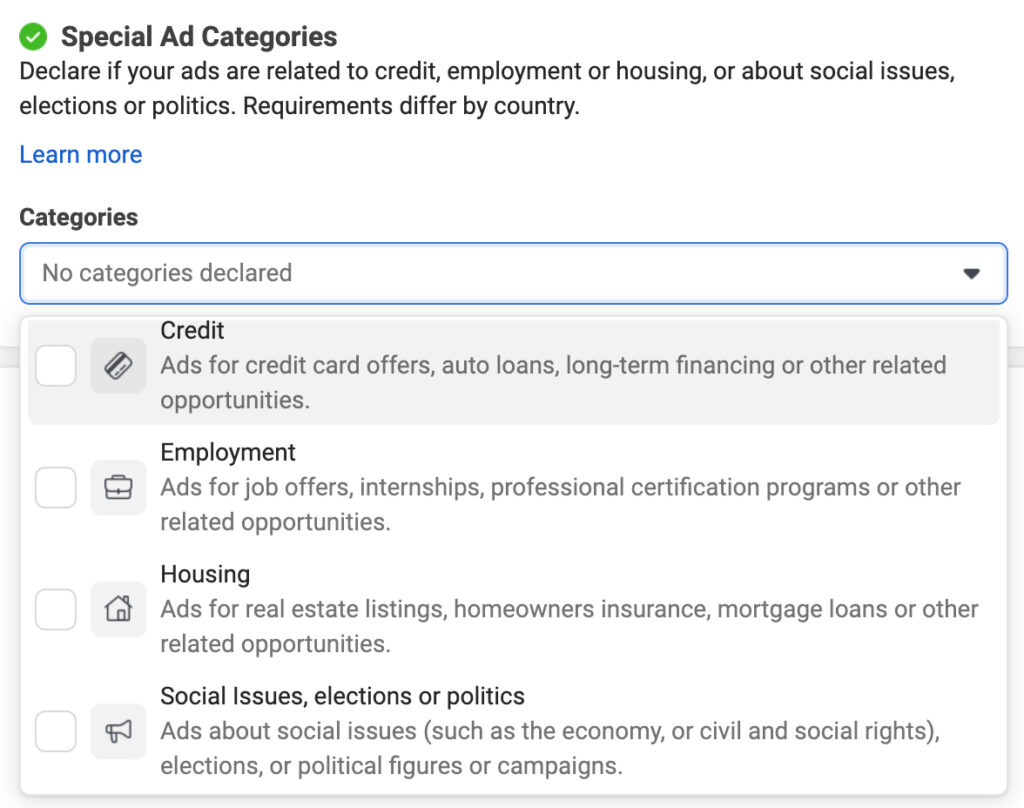According to Data Reportal : Facebook had 2.989 billion monthly active users in April 2023, placing it 1st in our ranking of the world’s most ‘active’ social media platforms. On 4th February 2004, Mark Zuckerberg decided to launch TheFacebook, before changing its name to simply Facebook in August 2005.
Since its launch in 2004, Facebook has undergone significant evolution. Like many social platforms, Facebook has transitioned from being primarily a social networking site to becoming a powerful tool for marketing and business growth for organizations. When used effectively, Facebook ads can yield impressive results and return on investment (ROI).
Each year, it appears that there are fresh insights for businesses and marketers to grasp in order to effectively manage their Facebook ad campaigns. Today, we’ll guide you about Facebook Special Ad Categories. Many Facebook webmasters are familiar with the concept of Facebook Special Ad Categories, while others may be actively seeking information through search engines.
Contents
What is Facebook Special ad Category?
Facebook’s Special Ad Category is a set of ad categories that are subject to additional restrictions and requirements in order to protect users from discrimination. These categories include ads for credit, employment, housing, and social issues and politics. If you are planning to run an ad in a Special Ad Category, it is important to carefully review Facebook’s advertising policies and requirements.
A Facebook Special Ad Category is a classification applied to certain types of advertisements that are subject to specific restrictions due to their nature and potential impact on protected characteristics. These categories were introduced by Facebook to address concerns related to discrimination, particularly in areas like housing, employment, and financial services.

The main purpose of Special Ad Categories is to ensure that advertisers do not use Facebook’s advertising tools to discriminate against individuals based on characteristics such as race, ethnicity, religion, age, gender, sexual orientation, disability, and more.
When advertisers create ads falling under the Special Ad Categories, they are subject to certain limitations on ad targeting. Facebook restricts the use of specific demographic and behavior-based targeting options to prevent discriminatory practices. Instead, targeting options are limited to broader characteristics such as location, age, and gender.
Types of Special Ad Categories on Facebook
When crafting a Facebook advertisement, it’s essential to choose a Special Ad Category if your ad’s content aligns with any of the categories listed below:
- Credit Ads : Advertisements that promote or provide direct links to credit opportunities, encompassing but not limited to credit card offers, car loans, personal or business loan services, mortgage loans, and long-term financing.
- Employment Ads : This category covers ads promoting job opportunities or recruiting efforts by employers.
- Housing Ads : This category includes ads related to housing opportunities, such as rental or sales listings for apartments, houses, or other residential properties.
- Social issues, elections and politics : These are ads about politicians, political parties, or elections. They can also be about social issues that are sensitive and may affect election results or proposed laws. These ads are regulated as political advertising.
Distinguishing Facebook’s Special Ad Category from Other Campaigns
Facebook’s Special Ad Category is different from other normal ads in several key ways:
- Targeting Restrictions: Special Ad Category ads have limited targeting options compared to normal ads. In an effort to prevent discrimination, advertisers cannot target specific demographics or behaviors that could be considered discriminatory. Instead, targeting options are restricted to broader characteristics such as location, age, and gender.
- Purpose and Classification: Special Ad Category ads are specifically designed for certain types of products or services, such as those related to housing, employment, and credit opportunities. These ads fall under a distinct category due to their potential impact on protected characteristics and the need to comply with anti-discrimination laws.
- Certification Process: For advertisers running ads in the housing, employment, or credit categories, Facebook may require them to complete a certification process to confirm their compliance with anti-discrimination laws and Facebook’s ad policies. Normal ads do not require this additional certification.
- Ad Content Restrictions: Special Ad Category ads must adhere to stricter guidelines to avoid promoting discriminatory content. They need to be mindful of the sensitive nature of the products or services they advertise and must not engage in practices that could lead to unfair housing or employment practices.
Also Read- 8 Ways to Boost Website Traffic via Facebook
Steps to Create a Campaign of special Ad Category
- Access Facebook Ads Manager: Log in to your Facebook Ads Manager account. If you don’t have one, create an account first.
- Choose the Objective: When creating a new ad campaign, select an objective that aligns with your Special Ad Category. For example, if you’re promoting housing opportunities, you might choose the “Reach” or “Traffic” objective.
- Set Up Ad Set: In the ad set creation process, choose your targeting options carefully. Remember that Special Ad Category ads have limited targeting options to avoid discrimination. Focus on broader characteristics like location, age, and gender.
- Select “Special Ad Category”: During the ad set creation, you’ll come across a section where you can choose the “Special Ad Category.” Indicate the relevant category that corresponds to your ad’s content, such as housing, employment, or credit.
- Ad Content: Create your ad content, ensuring it complies with Facebook’s policies and guidelines for Special Ad Category ads. Avoid any content that could be perceived as discriminatory or unfair.
- Complete the Process: Finish creating your ad by following the usual steps, including selecting your ad format, adding media (images or videos), and defining your budget and schedule.
- Certification (if applicable): Depending on your ad category and location, Facebook may require you to go through a certification process to confirm compliance with anti-discrimination laws. If prompted, complete the certification to proceed with running your ad.
- Review and Publish: Before submitting your ad, review all the details to ensure compliance with Facebook’s policies and the Special Ad Category requirements. Once everything is in order, submit your ad for review.
Facebook’s review process for special ad category ads might take longer than standard ads due to the additional scrutiny to ensure policy compliance. Be patient while waiting for the ad to be approved.
By implementing targeted restrictions and certification processes, Facebook aims to ensure that ads related to housing, employment, and credit opportunities are displayed responsibly and ethically. As an advertiser, understanding the unique characteristics and limitations of special ad category campaigns is essential for running successful and compliant campaigns. By adhering to the guidelines and crafting content that fosters inclusivity, you can reach your audience effectively while maintaining respect for protected characteristics.
